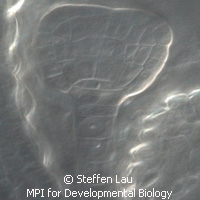Scientists uncover how a plant hormone triggers a genetic reaction
An EU-funded research project into how the plant hormone auxin triggers certain reactions has found that embryonic development shows similarities to a signalling pathway in embryonic stem cells in mammals. The study, published in Nature Cell Biology, was funded in part by a Marie Curie Intra-European Fellowship (EIF) under the 'Mobility' thematic area of the Sixth Framework Programme (FP6). During the development of organisms, various signals appear repeatedly that trigger specific actions. However, these triggered processes must also be maintained. The plant hormone auxin acts as a signalling molecule during embryo development in thale cress (Arabidopsis thaliana), a model plant often used in genetic studies. Building on previous work with auxin, German researchers from the Max Planck Institute for Developmental Biology and the University of Tübingen have now combined several components in a regulatory network that allows an increasing concentration of auxin to 'switch on' genes for the embryo's normal development. Once a certain point has been reached, the reactions do not cease, or only do so gradually, even if the auxin concentration declines. Normally, a plant embryo will become a seedling before growing into a fully fledged plant with roots, stem, leaves and flowers. These developmental foundations are laid during early embryonic development. Auxin is an important signal transmitter during this phase of development; for example, it promotes the breakdown of an inhibitor that can prevent certain factors from activating their target genes. In an early phase of embryo development, auxin concentration rises in the cells located at the top of the embryo, from which the above-ground parts of the plant will later form. Shortly afterwards, auxin is transported into the lower cells. However, this does not fully explain the exact role of auxin in pattern formation in the embryo. To fill in some of these blanks surrounding the effect of auxin, the researchers initially focused on a simplified system. Instead of carrying out their experiments with thale cress embryos, they worked with thale cress protoplasts, living cells without a cell wall with a less complex environment. Test conditions using protoplasts can be varied rather conveniently, and it is relatively easy to measure gene activity in these cells. Using this system, the team tested the effects of a gene-activating factor called MONOPTEROS and its inhibitor BODENLOS. The results showed that MONOPTEROS promotes both its own production and that of its inhibitor BODENLOS by forming a system comprising two linked feedback loops. The system is controlled by auxin, which promotes the breakdown of the inhibitor. When the concentration of auxin increases, breakdown of the inhibitor BODENLOS also increases. As a result, MONOPTEROS is less strongly blocked. And once a certain auxin concentration is reached, the MONOPTEROS-BODENLOS system is boosted to a higher level of activity. 'Everything points to the fact that auxin triggers a switch in the system. As long as the auxin concentration does not fall below a certain level, the activated system does not fall back to the initial level, even if most of the auxin is transported away,' says lead researcher Steffen Lau.For more information, please visit:Max Planck Institute for Developmental Biologyhttp://www.mpg.de/en
Countries
Germany



